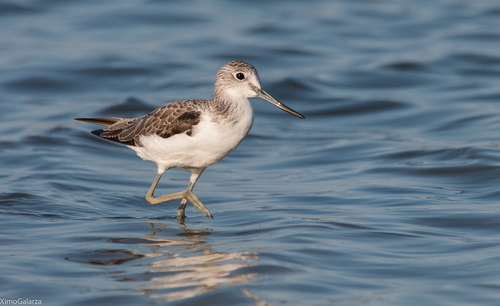
Common Greenshank
The Common Greenshank (Tringa nebularia) is a medium-sized wader known for its distinctive greenish legs and elegant profile. It plays a vital role in wetland ecosystems, primarily as a predator of small invertebrates and fish. This species exhibits a wide distribution, breeding across northern Eurasia and migrating south to Africa, Asia, and Australasia for the winter. While not currently considered globally threatened, the Common Greenshank faces increasing pressures from habitat loss and degradation, making it a species of conservation concern in some regions. It holds no particular, outstanding cultural significance, although, like many migratory birds, it can be seen as a herald of seasonal change.
30-35 cm
Length
55-65 cm
Wingspan
Least Concern
Conservation Status
Distribution
Breeds across northern Eurasia, from Scotland and Scandinavia eastward through Siberia to the Russian Far East. Migrates south to winter in Africa, southern Asia (including the Indian subcontinent, Southeast Asia, and Indonesia), and Australasia (primarily Australia and New Zealand). Altitudinal range varies from sea level to montane wetlands during breeding.
Lifespan
Average lifespan in the wild is estimated to be around 8-12 years, but some individuals can live longer.
Common Greenshank's Habitat
Habitat Types
Freshwater wetlands, Coastal marshes, Estuaries, Mudflats, Lakeshores, Riverbanks, Bogs, Moors
Climate Zones
Boreal, Temperate, Subtropical, Tropical
Adaptations
Long legs and a slightly upturned bill are adaptations for wading in shallow water and probing for prey in mud and sand. Their relatively long wings facilitate long-distance migration.
Variations
No widely recognized subspecies exist, although some subtle variations in size and plumage may occur across the extensive range.
Appearance
Breeding Plumage
Breeding plumage features more pronounced streaking and spotting on the head, neck, and breast, with a generally darker upperpart coloration. Non-breeding plumage is paler and greyer, with less distinct markings.
Seasonal Feather Changes
The transition between breeding and non-breeding plumage occurs through molting, typically after the breeding season and before migration.
Sex Based Plumage Differences
Minimal; males and females have very similar plumage.
Notable Features
Long, greenish legs (giving the bird its common name)., Slightly upturned, greyish bill., White rump and lower back, visible in flight., Dark grey-brown upperparts during breeding, becoming paler grey in non-breeding plumage.
Diet and Feeding
Primary Foods
Small fish, Aquatic invertebrates (insects, crustaceans, mollusks), Terrestrial invertebrates (worms, spiders), Amphibians (tadpoles, small frogs)
Foraging Behavior
Typically forages by wading in shallow water, probing the mud or sand with its bill. It may also pick prey from the water's surface or chase small fish. Often feeds actively, running or walking quickly.
Specializations
The slightly upturned bill is well-suited for probing and capturing prey in soft substrates.
Seasonal Diet Variations
Diet may shift slightly depending on prey availability. During breeding, insects and other invertebrates may be more prominent, while fish may become more important during migration and winter.
Behavior
Social Structure
Generally solitary or found in small, loose groups, especially during migration and winter. May form larger flocks at favored feeding or roosting sites.
Communication
Loud, ringing 'tew-tew-tew' call, often given in flight., Various other calls used during courtship and territorial defense.
Migration
A long-distance migrant, traveling between breeding grounds in northern Eurasia and wintering areas in Africa, Asia, and Australasia. Migration routes are often coastal, but some birds may cross large bodies of water or land.
Territorial or Group Behaviors
Territorial during the breeding season, defending nesting areas from other Greenshanks. Outside of breeding, they are generally less territorial, although they may defend feeding patches.
Conservation
Threats
Habitat loss and degradation (wetland drainage, pollution, coastal development), Climate change (affecting breeding habitats and prey availability), Hunting (in some parts of the range), Disturbance at breeding and wintering sites
Protection Programs
International agreements (e.g., Ramsar Convention on Wetlands, African-Eurasian Waterbird Agreement), National and regional protected areas (nature reserves, national parks), Habitat restoration projects
Local National Laws
Protected under various national and international laws, including the Migratory Bird Treaty Act in the United States (although the species is not native to North America) and similar legislation in other countries.
Population Trend
Decreasing
Population Estimates
The global population is estimated to be between 440,000 and 1,500,000 individuals.
Interesting Facts
The Common Greenshank is known for its nervous behavior.
It often bobs its head and flicks its tail when agitated or alert.
They are strong fliers.
Capable of undertaking long, non-stop migratory flights.
Their scientific name, *Tringa nebularia*, refers to their hazy, greyish plumage.
'Nebularia' comes from the Latin word 'nebula,' meaning mist or fog.
They sometimes wade quite deeply.
Occasionally submerging their entire body except for the head.
Faqs about Common Greenshank
Where can I see a Common Greenshank?
Look for them in suitable wetland habitats during migration or winter in Africa, Asia, and Australasia. During the breeding season, they are found in northern Eurasia.
What is the difference between a Common Greenshank and a Common Redshank?
The Greenshank has greenish legs and a slightly upturned bill, while the Redshank has bright red legs and a straight bill. Their calls are also distinct.
Are Common Greenshanks endangered?
They are currently classified as Least Concern by the IUCN, but their population is declining due to various threats.
How do they find food?
They use their long, sensitive bill to probe in mud and shallow water, detecting prey by touch.
Copyright @ Nature Style Limited. All Rights Reserved.
 English
English